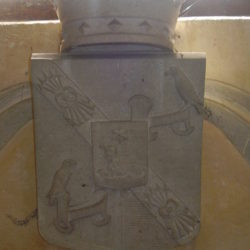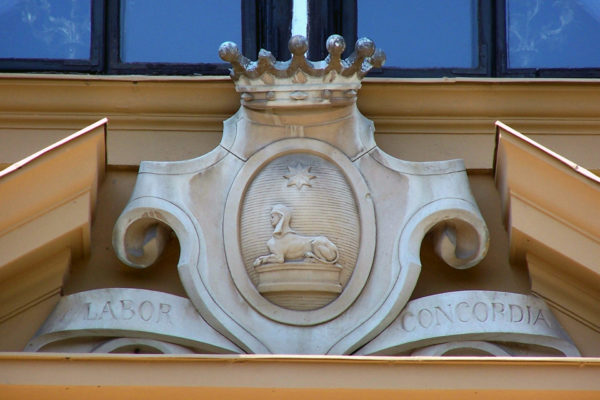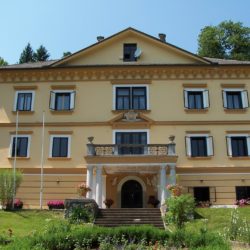
Coat of arms of the Schwegel family in Grimšče Mansion
REčICA PRI BLEDU, GRIMščE MANSION
Location of the coat of arms: façade
In the past and still today, Švegelj or Žvegelj continues to be a common family name in the Upper Carniolan countryside, especially in the area around Bled. The later-to-become Baron Josef von Schwegel was the son of local farmers, “the Balohs” from Zgornje Gorje. Despite living a humble life, the parents made sure that all their children, both sons and daughters, received good education. The oldest son Andreas became a physician. Josef, too, initially enrolled in medicine studies, but soon changed his mind and switched to the so-called Oriental Academy, where future Austrian diplomats were trained. His diplomatic career first led him to Alexandria, where, serving as a consul, he especially distinguished himself by organizing the visit of Emperor Franz Joseph to attend the inauguration of the Suez Canal. The organization of the imperial visit earned Schwegel an elevation to the hereditary rank of Austrian knighthood in 1870 and a transfer to Istanbul, where he became the consul general. In 1873, he again showed excellent organizational skills, this time as an organizer and curator of the outstanding Oriental Pavilion at the international exhibition in Vienna. For his merit he was decorated with the Order of Saint Stephen of Hungary, based on which he requested to be elevated to the rank of baron in 1875. In 1880, he abandoned diplomatic service and dedicated his life to commercial pursuits.
Already in 1869, Josef purchased Grimšče Mansion from Baron Johann von Grimschitz and later entrusted its remodeling to the renowned Slovenian architect Maks (Germ. Maximilian, Ital. Massimo) Fabiani. He further affirmed his ownership of the mansion by mounting a coat of arms on the façade above the main entrance which has been preserved to present day. The basic, knightly coat of arms depicts a sphynx symbolizing his relation to Egypt and the happy years of his first mission to Alexandria. Testifying to the fact that Schwegel already held the baronial title at the time when the coat of arms was created is the baronial seven-pointed coronet above the escutcheon and the ribbon with the motto LABOR CONCORDIA (Harmonious effort) below it.
In the course of the following years, Baron von Schwegel purchased from nearby farmers a number of land plots that formerly belonged to the castle but were sold by Baron von Grimschitz. Schwegel also owned a palace in Vienna and a villa in the coastal village of Volosko, which was another architectural feat by Maks Fabiani.
In 1868, Josef married Maria von Battisti di San Giorgio in Alexandria. Their only child, Maria (Mitzi), died of diphtheria at the tender age of six. Dying without issue in 1914, the baron therefore bequeathed his entire estate to his nephew, Dr. Ivan Švegel, an Austrian diplomat and later-to-become minister in the Živković government as well as envoy to Buenos Aires. Ivan took over his uncle’s wealth and on retiring settled in Grimšče Mansion, which he renamed “Wilsonia” as a tribute to the US President Woodrow Wilson, with whom he had a personal acquaintance.
Literatura:
Rugále, Mariano in Preinfalk, Miha: Blagoslovljeni in prekleti. 1. del: Plemiške rodbine 19. in 20. stoletja na Slovenskem. Ljubljana: Viharnik, 2010, pp. 170–173.
Rečica pri Bledu, Grimšče Mansion
Graščina Grimšce, Koroška cesta, Bled, SlovenijaOther coats of arms of the Schwegel

Coat of arms of the Barons Schwegel in Rečica pri Bledu
Rečica pri Bledu

